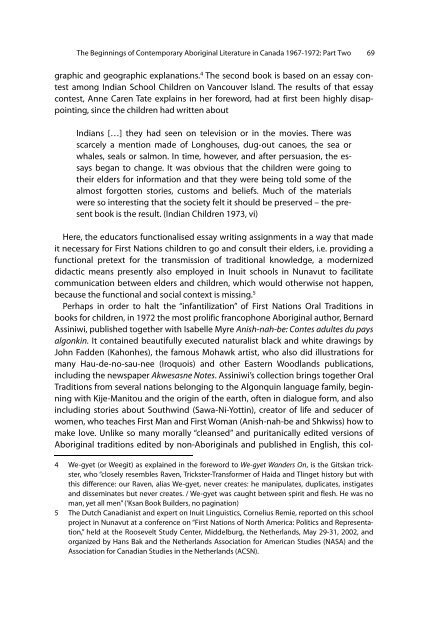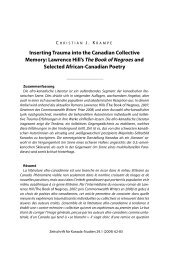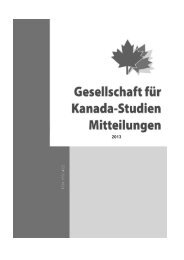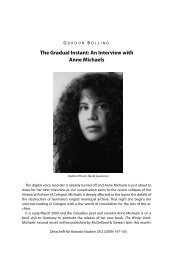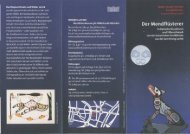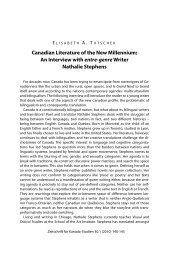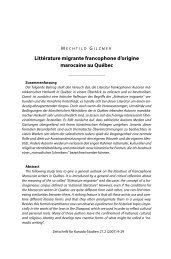The Beginnings of Contemporary Aboriginal Literature in Canada ...
The Beginnings of Contemporary Aboriginal Literature in Canada ...
The Beginnings of Contemporary Aboriginal Literature in Canada ...
You also want an ePaper? Increase the reach of your titles
YUMPU automatically turns print PDFs into web optimized ePapers that Google loves.
<strong>The</strong> <strong>Beg<strong>in</strong>n<strong>in</strong>gs</strong> <strong>of</strong> <strong>Contemporary</strong> <strong>Aborig<strong>in</strong>al</strong> <strong>Literature</strong> <strong>in</strong> <strong>Canada</strong> 1967-1972: Part Two 69<br />
graphic and geographic explanations. 4 <strong>The</strong> second book is based on an essay contest<br />
among Indian School Children on Vancouver Island. <strong>The</strong> results <strong>of</strong> that essay<br />
contest, Anne Caren Tate expla<strong>in</strong>s <strong>in</strong> her foreword, had at first been highly disappo<strong>in</strong>t<strong>in</strong>g,<br />
s<strong>in</strong>ce the children had written about<br />
Indians […] they had seen on television or <strong>in</strong> the movies. <strong>The</strong>re was<br />
scarcely a mention made <strong>of</strong> Longhouses, dug-out canoes, the sea or<br />
whales, seals or salmon. In time, however, and after persuasion, the essays<br />
began to change. It was obvious that the children were go<strong>in</strong>g to<br />
their elders for <strong>in</strong>formation and that they were be<strong>in</strong>g told some <strong>of</strong> the<br />
almost forgotten stories, customs and beliefs. Much <strong>of</strong> the materials<br />
were so <strong>in</strong>terest<strong>in</strong>g that the society felt it should be preserved – the present<br />
book is the result. (Indian Children 1973, vi)<br />
Here, the educators functionalised essay writ<strong>in</strong>g assignments <strong>in</strong> a way that made<br />
it necessary for First Nations children to go and consult their elders, i.e. provid<strong>in</strong>g a<br />
functional pretext for the transmission <strong>of</strong> traditional knowledge, a modernized<br />
didactic means presently also employed <strong>in</strong> Inuit schools <strong>in</strong> Nunavut to facilitate<br />
communication between elders and children, which would otherwise not happen,<br />
because the functional and social context is miss<strong>in</strong>g. 5<br />
Perhaps <strong>in</strong> order to halt the “<strong>in</strong>fantilization” <strong>of</strong> First Nations Oral Traditions <strong>in</strong><br />
books for children, <strong>in</strong> 1972 the most prolific francophone <strong>Aborig<strong>in</strong>al</strong> author, Bernard<br />
Ass<strong>in</strong>iwi, published together with Isabelle Myre Anish-nah-be: Contes adultes du pays<br />
algonk<strong>in</strong>. It conta<strong>in</strong>ed beautifully executed naturalist black and white draw<strong>in</strong>gs by<br />
John Fadden (Kahonhes), the famous Mohawk artist, who also did illustrations for<br />
many Hau-de-no-sau-nee (Iroquois) and other Eastern Woodlands publications,<br />
<strong>in</strong>clud<strong>in</strong>g the newspaper Akwesasne Notes. Ass<strong>in</strong>iwi’s collection br<strong>in</strong>gs together Oral<br />
Traditions from several nations belong<strong>in</strong>g to the Algonqu<strong>in</strong> language family, beg<strong>in</strong>n<strong>in</strong>g<br />
with Kije-Manitou and the orig<strong>in</strong> <strong>of</strong> the earth, <strong>of</strong>ten <strong>in</strong> dialogue form, and also<br />
<strong>in</strong>clud<strong>in</strong>g stories about Southw<strong>in</strong>d (Sawa-Ni-Yott<strong>in</strong>), creator <strong>of</strong> life and seducer <strong>of</strong><br />
women, who teaches First Man and First Woman (Anish-nah-be and Shkwiss) how to<br />
make love. Unlike so many morally “cleansed” and puritanically edited versions <strong>of</strong><br />
<strong>Aborig<strong>in</strong>al</strong> traditions edited by non-<strong>Aborig<strong>in</strong>al</strong>s and published <strong>in</strong> English, this col-<br />
4 We-gyet (or Weegit) as expla<strong>in</strong>ed <strong>in</strong> the foreword to We-gyet Wanders On, is the Gitskan trickster,<br />
who “closely resembles Raven, Trickster-Transformer <strong>of</strong> Haida and Tl<strong>in</strong>get history but with<br />
this difference: our Raven, alias We-gyet, never creates: he manipulates, duplicates, <strong>in</strong>stigates<br />
and dissem<strong>in</strong>ates but never creates. / We-gyet was caught between spirit and flesh. He was no<br />
man, yet all men” (‘Ksan Book Builders, no pag<strong>in</strong>ation)<br />
5 <strong>The</strong> Dutch Canadianist and expert on Inuit L<strong>in</strong>guistics, Cornelius Remie, reported on this school<br />
project <strong>in</strong> Nunavut at a conference on “First Nations <strong>of</strong> North America: Politics and Representation,”<br />
held at the Roosevelt Study Center, Middelburg, the Netherlands, May 29-31, 2002, and<br />
organized by Hans Bak and the Netherlands Association for American Studies (NASA) and the<br />
Association for Canadian Studies <strong>in</strong> the Netherlands (ACSN).


